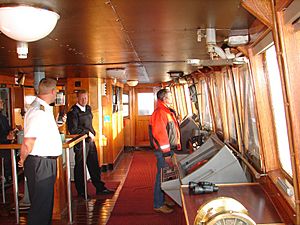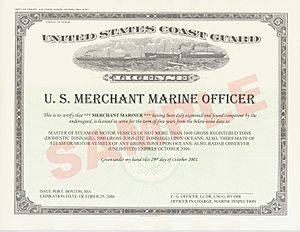Sea captain facts for kids

The master works with the harbour pilot, the chief mate and an able seaman during inner navigation aboard the vessel Kristina Regina.
|
|
| General | |
|---|---|
| Other names | Ship's captain, ship's master, shipmaster, captain, master |
| Department | Deck department |
| Location | At sea |
| Licensed | Yes |
| Duties | In charge of a merchant ship. |
| Requirements | master's license or extra master's license or commissioned officer |
| Watchstanding | |
| Watchstander | If needs |
A sea captain (also called a ship's captain, master, or shipmaster) is the person in charge of a merchant ship. They have the highest rank on the ship and are responsible for everything that happens on board. This includes making sure the ship is safe, secure, and runs smoothly. They also look after the cargo, the crew, and everyone else on the ship.
Contents
What Does a Sea Captain Do?
The captain makes sure the ship follows all the rules, both from the country where the ship is registered and from international laws. They are in charge of safely guiding the ship, keeping it clean, and making sure it can handle the sea. They also manage the crew, keep track of supplies, and handle all the ship's important papers.
Keeping the Ship Safe
One very important job for a captain is to follow the ship's security plan. This plan helps protect the ship from dangers like terrorists, pirates, or people trying to sneak onto the ship. It includes rules for checking the ship, keeping certain areas restricted, and knowing how to react to threats. The plan also covers situations with refugees, smugglers, or saboteurs.
Handling Cargo and People
The captain is responsible for all the cargo on the ship. They make sure it is loaded and unloaded safely. They also look after everyone on board, including the crew and any passengers. If someone gets hurt or sick, the captain must make sure they get medical help. This might mean getting help from doctors on land or even arranging for someone to leave the ship for more care.
Dealing with Port Rules
When a ship travels to different countries, the captain must deal with local immigration and customs officials. This means making sure all passengers and crew have the right papers to enter or leave a country. They also have to declare what cargo the ship is carrying and what supplies are on board.
What Happens if Things Go Wrong?
If the ship or its cargo gets damaged, or if the ship causes damage to another vessel or port, the captain has special duties. They work with investigators and must provide accurate records, reports, and evidence about what happened. For example, if the ship hits another ship, runs aground, or damages something in the port, the captain is responsible for documenting it. They also report problems like cargo getting wet or stolen.
More About Captains
Images for kids
-
Captain of the RMS Titanic, E J Smith
See also
 In Spanish: Capitán (náutica) para niños
In Spanish: Capitán (náutica) para niños




